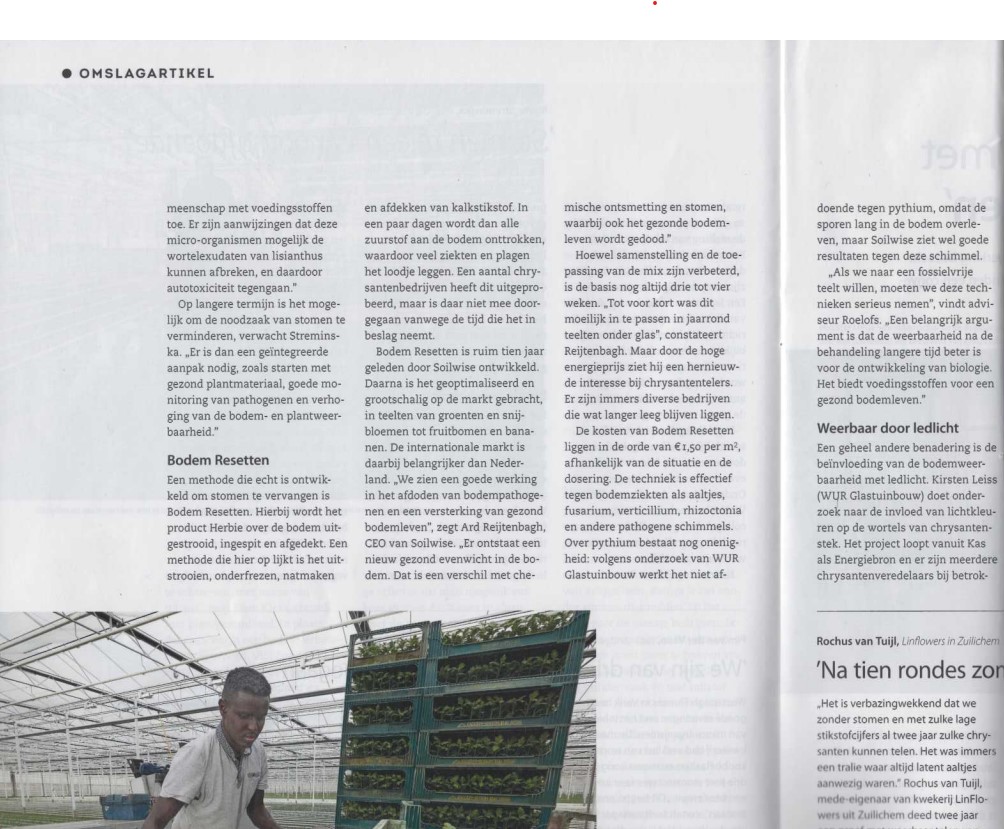Soil Resetting in the Trade journal for the floricultural industry
Soil Resetting was mentioned in a recent article in the “Trade journal for the Floricultural Industry” (a Dutch magazine, called Vakblad voor de Bloemisterij). The article discusses, among other things, the development and optimisation of Soil Resetting in the past 10 years, the markets in which we are active with Soil Resetting and the soil diseases against which Soil Resetting has proven to be effective.
One method that has truly been developed to replace steaming is Soil Resetting. This involves spreading the Herbie product over the soil, injecting it and covering it. A method similar to this is spreading, injecting, wetting and covering with lime nitrogen. In a few days all oxygen is then removed from the soil, which kills many diseases and pests. A number of chrysanthemum companies have tried it, but did not continue because of the time it takes.
Soil Resetting was developed by Soilwise more than ten years ago. After that it was optimised and marketed on a large scale for crops ranging from vegetables and cut flowers to fruit trees and bananas. The international market is more important here than the Netherlands. “We see a good effect in killing off soil pathogens and strengthening healthy soil life,” says Ard Reijtenbagh, CEO of Soilwise. “A new healthy balance is created in the soil. That’s a difference from chemical disinfection and steaming, where healthy soil life is also killed.”
Although composition and application of the mix have improved, the basis is still three to four weeks. Until recently, this was difficult to fit into year-round crops under glass,” Reijtenbagh observes. But because of the high energy price, he sees a renewed interest among chrysanthemum growers. After all, there are several farms that remain empty for a while.
The costs of Soil Resetting are in the order of €1.50 per m2 depending on the situation and dosage. The technique is effective against soil diseases such as nematodes, fusarium, verticillium, rhizoctonia and other pathogenic fungi. There is still disagreement about pythium: according to research by WUR Glasshouse horticulture, it is not effective against pythium, because the spores survive in the soil for a long time, but Soilwise sees good results against this fungus.
“If we want to move towards fossil-free cultivation, we have to take these techniques seriously,” says consultant Roelofs. An important argument is that after the treatment the resistance is better for the development of biology for a longer period. It provides nutrients for healthy soil life.”
One method that has truly been developed to replace steaming is Soil Resetting. This involves spreading the Herbie product over the soil, injecting it and covering it. A method similar to this is spreading, injecting, wetting and covering with lime nitrogen. In a few days all oxygen is then removed from the soil, which kills many diseases and pests. A number of chrysanthemum companies have tried it, but did not continue because of the time it takes.
Soil Resetting was developed by Soilwise more than ten years ago. After that it was optimised and marketed on a large scale for crops ranging from vegetables and cut flowers to fruit trees and bananas. The international market is more important here than the Netherlands. “We see a good effect in killing off soil pathogens and strengthening healthy soil life,” says Ard Reijtenbagh, CEO of Soilwise. “A new healthy balance is created in the soil. That’s a difference from chemical disinfection and steaming, where healthy soil life is also killed.”
Although composition and application of the mix have improved, the basis is still three to four weeks. Until recently, this was difficult to fit into year-round crops under glass,” Reijtenbagh observes. But because of the high energy price, he sees a renewed interest among chrysanthemum growers. After all, there are several farms that remain empty for a while.
The costs of Soil Resetting are in the order of €1.50 per m2 depending on the situation and dosage. The technique is effective against soil diseases such as nematodes, fusarium, verticillium, rhizoctonia and other pathogenic fungi. There is still disagreement about pythium: according to research by WUR Glasshouse horticulture, it is not effective against pythium, because the spores survive in the soil for a long time, but Soilwise sees good results against this fungus.
“If we want to move towards fossil-free cultivation, we have to take these techniques seriously,” says consultant Roelofs. An important argument is that after the treatment the resistance is better for the development of biology for a longer period. It provides nutrients for healthy soil life.”



“A new healthy balance is created in the soil. That’s a difference from chemical disinfection and steaming, where healthy soil life is also killed.”